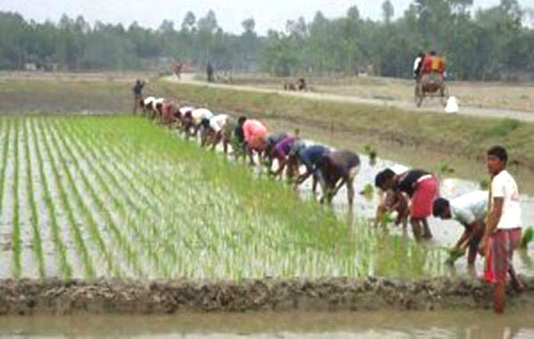RAJSHAHI, June 18, 2021 (BSS) – Aush paddy transplantation has gained momentum as the farmers are seen bustling with the plantation activities amid suitable climatic conditions everywhere in the region including its vast Barind tract at present.
The farmers have started the transplanting works in full swing just after completion of harvesting the boro paddy taking advantage of the monsoonal rainfall.
“We are getting benefits of recurrent rainfall for the transplantation purposes during the couple of weeks,” Ajmal Alam, a farmer of Harinbiska village under Godagari Upazila, said.
He said the Aush farming is very much cost effective as it requires less production cost and face less natural calamity.
More or less, the farming depends on monsoonal rainfall which is very important for lessening the gradually increasing pressure on groundwater.
Atanu Sarker, Sub Assistant Agriculture Officer, said the recurrent rainfalls are bringing fortune for the farmers towards the transplantation and growing process creating huge job opportunities for the labor-class people especially the indigenous males and females.
According to field-level reports, so far reached here, the farmers are showing more interest towards the Aush farming due to the effective measures taken by the government.
Meanwhile, around 6.44 lakh tonnes of Aush rice is expected to be produced from 2.46 lakh hectares of land in Rajshahi division during the current season.
Target has been set to produce 4.89 lakh tonnes of rice from 1.82 lakh hectares of land in Rajshahi, Naogaon, Chapainawabganj and Natore districts under Rajshahi agricultural zone while another 1.55 lakh tonnes from 63,728 hectares in Bogura, Joypurhat, Pabna and Sirajgonj districts under Bogura agricultural zone.
Sirajul Islam, Additional Director of the Department of Agriculture Extension (DAE), said a total of 69,300 small and marginal farmers received seed and fertilizers as incentives worth around Taka 6.07 crore for the cultivation of Aush paddy in the current Kharif-1 season in the division.
The beneficiary farmers were given five kilograms of high yielding seed, 20 kilograms of diammonium phosphate and 10 kilograms of potash fertilizers for aush paddy cultivation on one bigha of land each free of cost under the government’s agricultural incentive programme.
Agriculturist Sirajul Islam said the agricultural incentives will help boost aush paddy production as the country’s total production will be enhanced while the government has attached highest priority to the agriculture sector to cope with the present pandemic situation.
Some new paddy varieties released by Bangladesh Rice Research Institute (BRRI) have been playing a vital role in boosting aush rice through mitigating the crises of irrigation water in the division.
BRRI Principal Scientific Officer Dr Fazlul Islam said some of the new varieties including the BRRIdhan-48 have gained popularity among farmers in the Barind tract during the last couple of years.
BRRIdhan-48, a short duration and drought tolerant paddy variety has been giving satisfactory yield with scanty rainfall and limited irrigation in the area.
Sabiar Rahman, 58, a farmer of Pirijpur village under the same upazila, expressed his happiness over cultivating the variety saying its average yield is from 15 to 23 maunds per bigha.
He mentioned that the conventional parija variety is being replaced by the new variety which is a good sign for the region in terms of boosting yield.
The variety features early harvesting characteristics, supplementing the farming of transplanted Aman and various Rabi crops like tomato, brinjal, mustard and vegetables as the region is conventionally famous for farming these crops abundantly.
Dr Islam said there has been an enormous prospect of increasing food production through a successful promotion of the developed varieties.
To maintain sound soil health, it could be advisable to grow rice using a different system in order to improve compatibility between monsoon rice and upland winter crops.
In the previous year, the farmers have harvested around 7.42 lakh tonnes of Aush rice from 2.44 lakh hectares of land in the division



